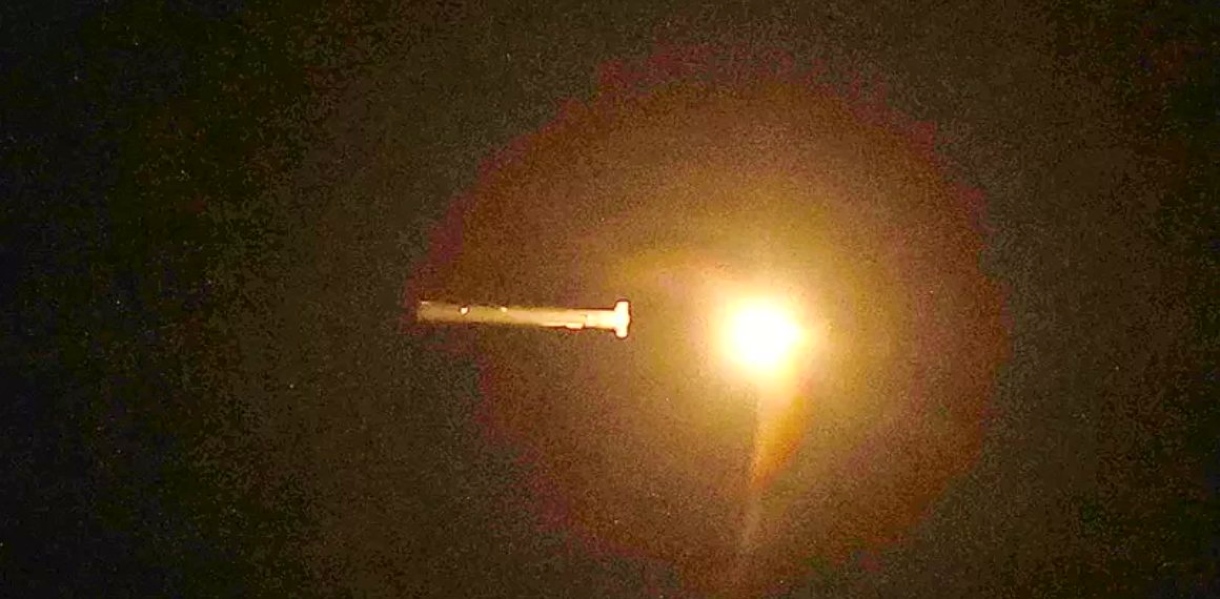A Taiwan-based media outlet has released images and video clips purporting to provide the first glimpse of the Hsiung Feng IIE land-attack cruise missile. This missile can strike targets deep within China.
Russia Unveils ‘Electronic Defense System’ To Defend Its Tanks From Ukraine’s ‘Deadly’ FPV Drones
On August 16, a report from United Daily News (UDN) disclosed that the Air Force had conducted a drill earlier that day involving launching an indigenously developed HF-2E surface-to-surface cruise missile.
Accompanying the article was imagery characterized by the newspaper as a depiction of the HF-2E missile. The UDN asserted that the missile remained airborne for several hours after being launched from Jiupeng military base in Pingtung County.
The missile, apparently in active service within the Taiwanese military for over a decade, has remained unseen by the public throughout this duration, constituting a discreet component of a range of undisclosed counter-strike capabilities possessed by Taiwan.
In a separate article, Taiwan’s semi-official Central News Agency (CNA) reported that an undisclosed military source informed them that the Air Force launched a classified missile on August 16.

This action was an integral facet of an ongoing three-day live-fire exercise in waters adjacent to Pingtung’s Jioupeng military base from August 15 through August 17. However, the source refrained from confirming whether the missile was an HF-2E.
Furthermore, the source elaborated that the Air Force’s primary fighter jets, which encompass Mirage-2000s, IDFs, and F-16Vs, were actively engaged in the maneuvers and launched a variety of missiles, including French-manufactured MICA missiles, domestically developed Sky Sword II air-to-air missiles, and US-sourced AIM-120 Advanced Medium-Range Air-to-Air Missiles.
The report also highlighted that naval and Coast Guard vessels participated in the drills. Nonetheless, the island’s military also refrained from confirming the exact identity of the missile launched on Wednesday morning.
However, Su Tzu-yun, a government-funded Institute for National Defense and Security Research (INDSR) scholar, told CNA that the missile in question was indeed the HF-2E.
He substantiated his viewpoint by referencing the video clip released by UDN, wherein the missile exhibited a two-stage ignition procedure, coupled with the report indicating the missile’s flight duration of approximately an hour.
Hsiung Feng 2E Surface-to-Surface Cruise Missile
The latest report doesn’t present any substantial fresh insights about the HF-2E, which remains shrouded in limited official information.
This missile is recognized as a ground-launched land-attack cruise missile, featuring a design resembling the US Tomahawk in structure and operation.
Taiwan’s military embarked on developing the HF-2E missile in the early 2000s; however, the existence of this missile remained undisclosed until March 2022, when its mention appeared in a report submitted to lawmakers for assessment.
According to the report, the extended-range iteration of the HF-2E boasts the capability to engage targets as far as 1,200 kilometers away; nevertheless, the military has abstained from releasing any photographic or video evidence of the missile.
While the Ministry of National Defense’s report didn’t specify the precise number of HF-2E missiles produced thus far, it did outline plans for the annual production of 131 HF-2 and HF-2E missiles starting in 2024.
It has been reported that there are no less than two different HF-2E variants, each embodying distinct characteristics—the baseline version and an extended-range iteration.
However, reports offer limited information concerning the maximum ranges attributed to both versions. The base design is believed to have the capability to effectively engage targets positioned within a span of 300 to 600 kilometers (equivalent to 186 to 372 miles).
In contrast, the enhanced variant is said to exhibit an elevated operational range, purportedly granting it the capacity to precisely strike designated targets positioned over significantly greater distances, ranging from 1,000 to 1,500 kilometers.
Built upon a mobile land platform, the missile relies on a solid-fueled booster and a liquid-fueled turbojet engine for propulsion. Its trajectory is directed through the integration of INS/GPS guidance systems, while its strike precision is further enhanced by leveraging terrain-matching technology.
Some experts suggest that the missile boasts a pre-terminal accuracy of 15 meters Circular Error Probable (CEP). Furthermore, certain accounts indicate the inclusion of an imaging infrared seeker in the missile’s design, a feature to augment its accuracy.
This enhancement mirrors capabilities seen in other land attack cruise missiles such as the US AGM-158 Joint Air-to-Surface Standoff Missile (JASSM), Storm Shadow, and more recent iterations of the Tomahawk missile.
While the specifics of the missile’s capabilities remain uncertain, the potential revelation of the HF-2E to the public marks a significant development. This revelation coincides with a period of heightened apprehension, as mounting concerns center around the possibility of Chinese military intervention in Taiwan in the coming years.
The presence of this long-range missile also sheds light on Taiwan’s strategic efforts to address and prepare for the evolving regional security landscape, where discussions about the potential for a Chinese incursion across the Taiwan Strait have gained prominence.
- Contact the author at ashishmichel(at)gmail.com
- Follow EurAsian Times on Google News